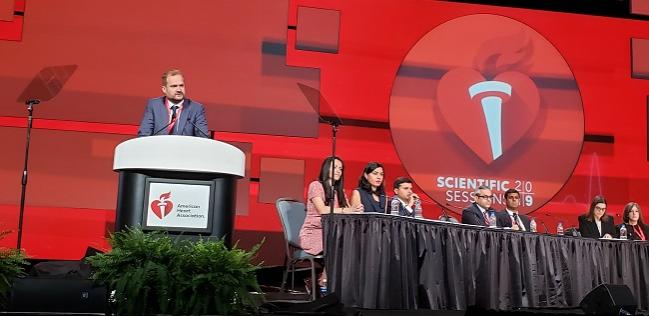Swift Angiography in Cardiac Arrest Without STEMI: No 1-Year Survival Benefit
Angiography remains “essential” but its timing is not, long-term COACT data confirm.

PHILADELPHIA, PA—Immediate angiography among comatose cardiac arrest patients who lack signs of STEMI and are successfully resuscitated does not offer any long-term benefit compared with a delayed strategy, 1-year follow-up data from the COACT trial confirm.
Researchers found no difference in survival or in the rates of MI, revascularization, rehospitalization due to heart failure, or implantable cardioverter-defibrillator shocks between immediate and delayed angiography.
The findings, presented here November 17 at the American Heart Association (AHA) 2019 Scientific Sessions, provide further reassurance after 90-day follow-up showing no survival advantage was released in March at the American College of Cardiology meeting.
“International guidelines recommend immediate coronary angiography and PCI in patients who present with ST-segment elevation myocardial infarction and cardiac arrest,” designating it Class I with level of evidence B, Jorrit Lemkes, MD (Amsterdam University Medical Centre, the Netherlands), told AHA attendees. When STEMI isn’t present, he added, guidelines still recommend emergency angiography, albeit weakly due to the evidence being of very low quality.
The COACT trial is the first randomized study to address whether such speed is necessary, and its investigators embarked with the hypothesis that immediate angiography would improve 90-day survival. Prior observational studies had backed an early-angiography approach in these patients, Lemkes pointed out.
Discussing the new results in the AHA late-breaking session, Joaquin E. Cigarroa, MD (Oregon Health & Science University, Portland), called COACT “an outstanding clinical trial answering and addressing important issues for patients and clinicians.”
He emphasized that COACT was a comparison of strategies for angiography, pointing out: “Although revascularization was performed if indicated (lesions greater than 70%), this was not a trial comparing revascularization to no revascularization.”
Instead the premise is that early angiography might enable the identification and treatment of coronary stenoses, with the aim of preventing further ischemia and improving outcomes, Cigarroa explained. This premise, however, did not bear out.
Angiography ‘Essential’ but Timing Isn’t
COACT, conducted at 19 Dutch hospitals, enrolled 552 patients with out-of-hospital cardiac arrest and no signs of STEMI, randomizing them to immediate or delayed angiography after neurological recovery. Nearly 80% had witnessed cardiac arrest.
In the immediate-angiography group, the procedure was performed as soon as possible after presentation, while in the delayed group it was performed in most cases after discharge from the ICU. Median time from randomization to angiography was 0.9 hours in the immediate group and 120 hours in the delayed group. Ultimately, 97.0% and 64.7% of patients in these groups underwent angiography, respectively.
One-year follow-up data were available for 522 patients, representing 94.5% of the original cohort. By that time, the survival rate was 61.4% with immediate and 64.0% with delayed angiography (OR 0.90; 95% CI 0.63-1.28). Kaplan-Meier analyses confirmed no difference at 1 year, as well as no difference in landmark analyses looking at the periods before 90 days and between 90 days and 1 year. In addition to the similarity shown for various secondary endpoints—MI rates, for example, were less than 1% in both groups—the RAND-36 questionnaire revealed no difference in mental or physical function at 1-year follow-up.
Cigarroa observed that the lack of long-term difference should not come as a surprise, given not only the 90-day outcomes but also the balance between groups in terms of the degree of myocardial injury, evidence of ischemia, duration of inotropic support, and success of temperature target management.
“At present, the results of COACT with regards to primary and secondary outcomes should guide practitioners that angiography remains essential but that early angiography does not improve outcomes compared to delayed angiography,” he concluded, predicting that the ACCESS and DISCO trials will add clarity to the discussion going forward.
Caitlin E. Cox is News Editor of TCTMD and Associate Director, Editorial Content at the Cardiovascular Research Foundation. She produces the…
Read Full BioSources
Lemkes J. One-year outcomes of coronary angiography after cardiac arrest without ST segment elevation: results of the COACT trial. Presented at: AHA 2019. November 17, 2019. Philadelphia, PA.
Disclosures
- COACT was supported by unrestricted research grants from the Netherlands Heart Institute, Biotronik, and AstraZeneca.
- Lemkes and Cigarroa report no relevant conflicts of interest.


Comments